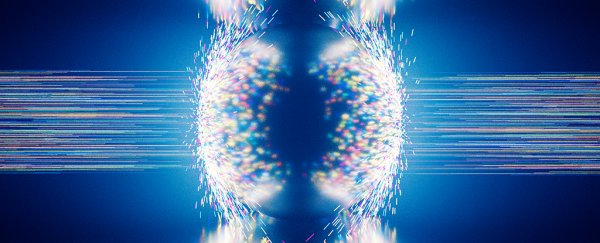A group of physicists are questioning our understanding of how quarks - a type of elementary particle - arrange themselves under extreme conditions. And their quest is revealing that elements beyond the edge of the periodic table might be fair weirder than we thought.
Deep in the depths of the periodic table there are monsters made of a unique arrangement of subatomic particles. As far as elements go, they come no bigger than oganesson – a behemoth that contains 118 protons and has an atomic mass of just under 300.
That's not to say protons and neutrons can't be arranged into even bigger clumps and still remain somewhat stable for longer than an eye blink. But for all practical purposes, nobody has discovered it yet.
While scientists speculate over how far the frontiers of the periodic table stretch, it's becoming clear that as atoms get bigger, the usual rules governing their behaviour change.
In this latest study, physicists from the University of Toronto argue that the constituent particles making up an atom's protons and neutrons could break their usual bonds under extreme conditions and still retain enough stability for the atom to stick around.
There are six types of these particles, called quarks, with the rather odd names of up, down, charm, strange, top, and bottom. Protons contain two up types and a down type. Neutrons, on the other hand, are made of two downs and a single up.
Quarks aren't limited to these configurations, though finding other arrangements is often rare thanks to the fact few stay stable very long.
A little over thirty years ago, a physicist named Edward Witten proposed that the energy keeping combinations of quarks in triplets could achieve something of a balance if put under sufficient pressure, such as that inside a neutron star.
This 'strange quark matter' (or SQM) would be a relatively equal mix of up, down, and strange quarks arranged not in threes, but as a liquid of numerous buzzing particles.
Given the fact up and down quarks get along well enough to form teams inside protons and neutrons, the possibility of making quark matter without strange quarks to mix things up has been generally dismissed.
According to physicists Bob Holdom, Jing Ren, and Chen Zhang, doing the actual sums reveals up-down quark matter, or udQM, might not only be possible, but preferable.
"Physicists have been searching for SQM for decades," the researchers told Lisa Zyga at Phys.org. "From our results, many searches may have been looking in the wrong place."
The team went back to basics and question the lowest energy state of a big bunch of squirming quarks.
They discovered that the ground state – that comfortable lobby of energy levels for particles – for udQM could actually be lower than both SQM and the ground state of the triplets inside protons and neutrons.
So if bunches of quarks are given enough of a push, they could force the ups and downs to pool into a liquid mess at energies that don't need the help of strange quarks.
Neutron stars could provide just such a squeeze, but it's no secret that the hearts of atoms themselves are pretty intense places as far as forces go.
The team suggest elements with atomic masses greater than 300 might also provide the right conditions to force up and down quarks to loosen up and party.
Making these elements would be a challenge that would require some way to pile on the neutrons to make supermassive elements stable enough.
But the lower ground states of udQM point the way to stable regions beyond the edges of the periodic table.
Exactly what these heavy elements look like or how they behave is hard to say for now, but it's unlikely they'd be following the usual rules.
There's also a chance that udQM could shoot across the Universe in the form of cosmic rays, and potentially be caught here on Earth. Or even produced inside particle accelerators.
"Knowing better where to look for udQM might then help to achieve an old idea: that of using quark matter as a new source of energy," the researchers claim.
Stable droplets of quarks wouldn't behave like usual quark clusters found in protons and neutrons, with lower masses that could potentially make them easier to control.
Quark matter reactors sound like the stuff of science fiction. But if this research is anything to go by, a whole new field of applied physics could be just over the horizon.
This research was published in Physical Review Letters.
